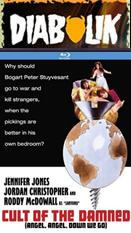
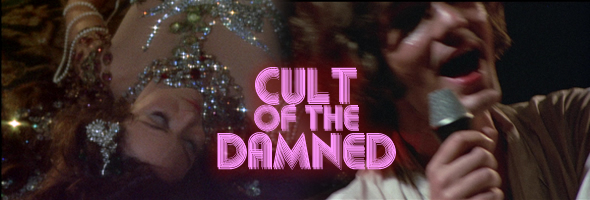
Color, 1969, 93m.
Directed by Robert Thom
Starring Jennifer Jones, Jordan Christopher, Holly Near, Roddy McDowall, Lou Rawls, Charles Aidman, Davey Davison
Kino Lorber (Blu-ray & DVD) (US RA/R1 HD/NTSC) / WS (1.85:1) (16:9)


Color, 1969, 93m.
Directed by Robert Thom
Starring Jennifer Jones, Jordan Christopher, Holly Near, Roddy McDowall, Lou Rawls, Charles Aidman, Davey Davison
Kino Lorber (Blu-ray & DVD) (US RA/R1 HD/NTSC) / WS (1.85:1) (16:9)
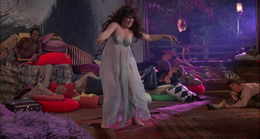
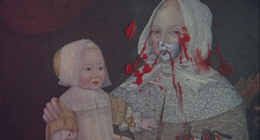 item for the '60s youth market was designed by American International Pictures as a sure-fire hit after their counterculture success, Wild in the Streets. Producer Sam Katzman, a semi-legend in drive-in circles, recruited that film's writer, Robert Thom, to pen and direct this ode to rock 'n' roll and wild Hollywood excess for his new production company, Four Leaf Productions, with his son serving as producer. Originally released as Angel, Angel, Down We Go, the film opening in August of 1969, the same month the love generation symbolically died with the Manson murders at Spahn Ranch. When the film bombed, AIP reissued it in 1971 under its more familiar title now, Cult of the Damned, usually paired up with The Vampire Lovers and featuring tacky artwork designed to echo the famous real-life murder spree. What viewers got instead was a music-filled black comedy with dashes of sadism and gothic horror, a combination unlike anything you'd ever see on screens today. If you're on the right wavelength, it's an unforgettable and genuinely delirious experience.
item for the '60s youth market was designed by American International Pictures as a sure-fire hit after their counterculture success, Wild in the Streets. Producer Sam Katzman, a semi-legend in drive-in circles, recruited that film's writer, Robert Thom, to pen and direct this ode to rock 'n' roll and wild Hollywood excess for his new production company, Four Leaf Productions, with his son serving as producer. Originally released as Angel, Angel, Down We Go, the film opening in August of 1969, the same month the love generation symbolically died with the Manson murders at Spahn Ranch. When the film bombed, AIP reissued it in 1971 under its more familiar title now, Cult of the Damned, usually paired up with The Vampire Lovers and featuring tacky artwork designed to echo the famous real-life murder spree. What viewers got instead was a music-filled black comedy with dashes of sadism and gothic horror, a combination unlike anything you'd ever see on screens today. If you're on the right wavelength, it's an unforgettable and genuinely delirious experience.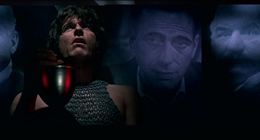 through the eyes of Tara Nicole Steele (folk singer Near), the young, plump daughter of two degenerate Hollywood denizens, former stag loop star Astrid (Oscar winner Jones in her penultimate role) and repressed gay businessman Willy (TV vet Aidman). Her childhood was filled with squabbling and barely concealed debauchery, resulting in her being shipped off to a boarding school in Switzerland. Upon her return, Astrid arranges a fancy, flashy debutante ball complete with a trendy rock band, the Rabbit Habit, whose swaggering, shirtless lead singer,
through the eyes of Tara Nicole Steele (folk singer Near), the young, plump daughter of two degenerate Hollywood denizens, former stag loop star Astrid (Oscar winner Jones in her penultimate role) and repressed gay businessman Willy (TV vet Aidman). Her childhood was filled with squabbling and barely concealed debauchery, resulting in her being shipped off to a boarding school in Switzerland. Upon her return, Astrid arranges a fancy, flashy debutante ball complete with a trendy rock band, the Rabbit Habit, whose swaggering, shirtless lead singer, 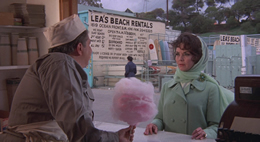 Bogart Peter Stuyvesant (Star 80's Christopher), sends Tara into a food-gulping frenzy of sexual panic. After the party she almost gets run over by Bogart's car and ends up spending the night with him, which soon results in his entire band taking over her life and household. Among the unlikely members are Santoro (McDowall), Joe (Rawls), and Anna (Davison), all of whom enjoy escaping from reality through any means possible and playing mind games with the materialistic Astrid, who also ends up in bed with Bogart. Of course, it's only a matter of time before things take a dark, deadly turn for everyone involved.
Bogart Peter Stuyvesant (Star 80's Christopher), sends Tara into a food-gulping frenzy of sexual panic. After the party she almost gets run over by Bogart's car and ends up spending the night with him, which soon results in his entire band taking over her life and household. Among the unlikely members are Santoro (McDowall), Joe (Rawls), and Anna (Davison), all of whom enjoy escaping from reality through any means possible and playing mind games with the materialistic Astrid, who also ends up in bed with Bogart. Of course, it's only a matter of time before things take a dark, deadly turn for everyone involved.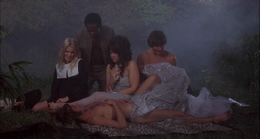 transforming classical paintings into disturbing images of garish violence, and peppering the soundtrack with a disorienting stream of pop songs (penned by the Wild in the Streets team of hit songwriters Barry Mann and Cynthia Weil) and caustic experimental music and sound effects. As with Wild in the Streets, it barely flows like a traditional narrative and doesn't build to anything like a normal climax; instead it seems to wander around to the own peculiar tempo in its head and resolves on a note of downbeat, ethereal strangeness. On top of that the visual
transforming classical paintings into disturbing images of garish violence, and peppering the soundtrack with a disorienting stream of pop songs (penned by the Wild in the Streets team of hit songwriters Barry Mann and Cynthia Weil) and caustic experimental music and sound effects. As with Wild in the Streets, it barely flows like a traditional narrative and doesn't build to anything like a normal climax; instead it seems to wander around to the own peculiar tempo in its head and resolves on a note of downbeat, ethereal strangeness. On top of that the visual 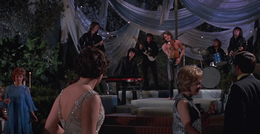 scheme is genuinely startling, mixing rich, Bava-style lighting in some scenes with flat, mundane TV-inspired set ups in others.
scheme is genuinely startling, mixing rich, Bava-style lighting in some scenes with flat, mundane TV-inspired set ups in others. ![]()